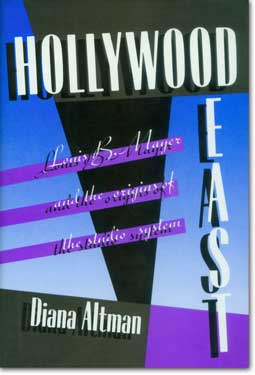|
Hollywood East
 HOLLYWOOD EAST: HOLLYWOOD EAST:
Louis B. Mayer and the origins of the studio system
Before there was Hollywood:
- Metro was a struggling film distribution company.
- Goldwyn was a glove salesman named Sam Goldfish.
- Mayer was a guy named Louis, who owned two small-town movie theaters: one known as the Garlic Box and one (a little nicer) with a big oil painting of a lion in the lobby.
And none of them were anywhere near California.
Hollywood East tells the story of how the movies evolved as a business—a business controlled from the Eastern seaboard. As Diana Altman notes, “Hollywood was a pretty face but New York was the heart and lungs.”
How did the business of movies grow? Who were the men and women who made it grow? Where did all the innovations—technical and business—come from? What innovative twists did mobsters Al Capone and Willie Bioff add?
Most film historians concentrate on the Hollywood studios and treat the New York side as an unimportant annoyance to the creative geniuses of Hollywood. In fact, New York ran the whole show, and the geniuses were merely employees as far as New York was concerned. And artistic innovations weren’t limited to the West Coast either. Many of the elements of film art and technology were developed in the East. The star system itself was an eastern innovation. James Stewart, Joan Crawford, Ava Gardner, Franchot Tone, Bob Hope, Henry Fonda, and many, many other stars got their start in the Fifty-fourth Street Manhattan studio where the screen test was invented.
Hollywood East is the story of Louis B. Mayer from his days as a film exhibitor through his stewardship as studio head at Metro-Goldwyn-Mayer, through his bitter battles with Nicholas Schenck and Dore Schary, his dismissal from the company bearing his name, and the proxy fight to regain control.
It is the story of William Fox, who at one time had ambitions of controlling the entire film production industry and had a net worth of $100 million before the stock market crashed and he was sent to prison for bribing a judge.
It is the story of Marcus Loew, Adolph Zukor, Jesse Lasky, Samuel Goldwyn, Cecil B. DeMille, and the other giants of the twenties.
It’s all here: how the stars emerged, how the public relations mills did their jobs. And the book explains how the moguls always put aside their rivalries when they were threatened by adverse publicity.
Many of the photographs in the book are from the one-of-a-kind collection of the author’s father.
Purchase the book


Comments
From Publishers Weekly
Altman (whose father was a former MGM East Coast talent scout) outlines the early careers of such film-industry founders as Adolph Zukor, Albert Warner, William Fox, Marcus Loew and others, making the point that the industry's true headquarters during its first five decades was not Hollywood but New York City. Her narrative spotlight is aimed mainly at Louis B. Mayer, the very emblem of the Hollywood movie mogul who, it turns out, was answerable to bosses at 1540 Broadway ("across the street from the Camel Cigarette sign blowing smoke"). Altman describes the cutthroat competition among industry pioneers, attempts by organized crime to muscle in--Mayer was one of the few movie moguls to fight back--and the changes wrought by WW II and the postwar advent of drive-in theaters and television. Finally, she relates the story of Mayer's dismissal in 1957 by the powers at corporate headquarters in Times Square and his brave comeback attempt, which failed when MGM stockholders voted against him. Photos.
From Library Journal
Film historian Altman...writes from a bird's-eye view of the rise of American motion pictures with Mayer just one of the various personalities who had a part. Twentieth-century world history, cinema history, biography, news clippings, and anecdotes come together in a blunt style that somehow works beautifully and cleanly. This is sophisticated storytelling and admirable history that reads like historical fiction. It even includes a poem by Rudolph Valentino.
From the New York Times
The Making Of a Mogul
Published: March 14, 2004
To the Editor:
Re ''Such Stuff as Dreams Are Made On'' (Feb. 29): Thanks for reminding us of the debt we owe to the movie theater mogul Marcus Loew who was, as your article states, ''almost universally revered.''
Loew's colleagues took it on themselves to help him succeed. One such individual was Sime Silverman, founder of Variety, who used to notice new housing developments as he motored around the city on weekends to escape from Midtown. So that no other theater man would have a chance to discover the location, he published the news the next day, as in ''Marcus Loew is developing a new realty project on the Grand Concourse, and a prime focal point will be a deluxer in the Bronx.'' Loew read this news in Variety, investigated the site and built Loews Paradise.
DIANA ALTMAN
Upper East Side
The writer is the author of ''Hollywood East: Louis B. Mayer and the Origins of the Studio System.''
Filled with unique photographs of the early days of the film indstry and the stars and people who made it great.
|